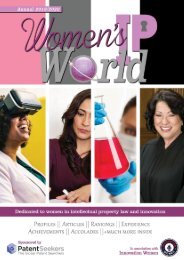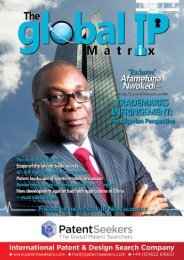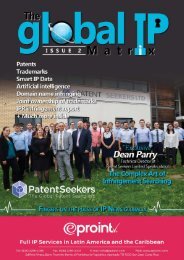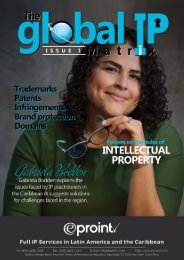Global IP Matrix - Issue 5
It has been a fantastic year for The Global IP Matrix magazine, thanks to all the efforts made by our contributors and to you, the reader for your continued support. We take great pleasure in putting together each issue of this publication, and we sincerely hope you enjoy this final issue of 2019. We have again, collaborated with some of the world's most influential IP law firms and businesses to bring you another eclectic mix of content, direct from the professionals working at ground level. We are already excited for the coming year and cannot wait to continue growing and evolving in our partnerships to bring you some exciting new features for 2020. Ms. Elvin Hassan Editor & Head of international liaisons
It has been a fantastic year for The Global IP Matrix magazine, thanks to all the efforts made by our contributors and to you, the reader for your continued support. We take great pleasure in putting together each issue of this publication, and we sincerely hope you enjoy this final issue of 2019. We have again, collaborated with some of the world's most influential IP law firms and businesses to bring you another eclectic mix of content, direct from the professionals working at ground level. We are already excited for the coming year and cannot wait to continue growing and evolving in our partnerships to bring you some exciting new features for 2020.
Ms. Elvin Hassan
Editor & Head of international liaisons
You also want an ePaper? Increase the reach of your titles
YUMPU automatically turns print PDFs into web optimized ePapers that Google loves.
The most startling growth in a sub-category (calculated by most common classification codes) has been in CPC<br />
code ‘G05D1’ – the control of position course or altitude of land, water, air, or space vehicles, e.g., automatic<br />
pilot – which has grown from 99 families in 2010 to 2639 families in 2018. Already, this classification code<br />
has 2480 families from 2019, and we are only 8 months into the year (at time of writing) which shows it is a<br />
technology area that is continuing to grow year on year.<br />
Also, worth a mention is the CPC code ‘B60W30’ – purposes of road vehicle drive control systems not related<br />
to the control of a particular sub-unit – which increased from 510 families in 2010 to 2618 families in 2018.<br />
The other remaining CPC codes in the top 5 for this result set are Y02T10 (road transport of goods or<br />
passengers), B60W10 (conjoint control of vehicle sub-units of different type or function) and F16H61 (control<br />
for changing speeds or reversing gearings for conveying rotary motion, control of exclusively fluid gearing,<br />
friction gearing, gearings with endless flexible members or other particular types of gearing).<br />
Who are the key players?<br />
Considering that Japan has a thriving automotive<br />
industry and that 9 of the top 20 assignees are<br />
Japanese companies to compared to only 3 US<br />
companies, you might expect to find Japan at the<br />
top of the list. However, much work in this area is<br />
being done in the US, from Silicon Valley companies<br />
like Waymo and Uber to traditional automotive<br />
companies like Ford Motor.<br />
Studying the jurisdictions that the top assignees are<br />
filing in most also supports this picture; 9 of the top<br />
10 companies in this technology area are prioritising<br />
Germany and the US, with both countries featuring<br />
in the top 3 locations that all 9 companies are filing<br />
in.<br />
Who are the main opinion<br />
leaders in this field?<br />
Top 20 assignees by families<br />
Unsurprisingly in this technology area, the top 20 assignees are dominated by large automotive companies –<br />
the majority of which would be considered household names. The top 20 assignees are made up of 9 Japanese<br />
companies, 6 German companies, 3 US companies, and 2 French companies.<br />
Companies like Bosch and Hitachi might not be considered part of the automotive industry, but as multinational<br />
conglomerate companies, their involvement in this area is to be expected. At the end of 2018, Bosch<br />
announced their intention to develop “pods,” similar to the small driverless vehicles that Google has tested<br />
in California. The idea being that one-day people will be able to hail these pods in the same way they do a<br />
taxi. They have also started work on including automated freeway driving and parking in premium vehicles.<br />
Hitachi’s experience in IT and operational technology (OT) has helped in launching their “Lumada” Internet<br />
of Things platform, utilising AI, security, analytics and more, to support a range of businesses in connected<br />
services and autonomous driving from the cloud.<br />
Where are the key players filing their inventions?<br />
Top 20 jurisdictions by families, applications & grants<br />
The top 5 jurisdictions for filing in this area are the US (26,000+ families), Germany (21,000+ families), China<br />
(15,000+ families), Japan (14,000+ families) and the European Patent Office (10,000+ families).<br />
www.gipmatrix.com<br />
Citation network for forward citations<br />
Studying the citations for the data set provides a<br />
novel way of interrogating the data. For instance,<br />
in the citation network above (showing the forward<br />
citations by assignee in the driverless cars technology<br />
area) the most cited companies by a significant<br />
amount – and therefore the most influential – are<br />
Nissan (8524 forward citations) and Toyota (5531<br />
forward citations).<br />
It makes sense that Toyota is receiving a lot of<br />
forward citations as they are one of the biggest filers<br />
in this area; however, Nissan Motor is the 5th biggest<br />
filer and yet is outperforming Hyundai, Toyota, ZF<br />
Friedrichshafen and Bosch in number of forward<br />
citations.<br />
The number of forward citations is also a useful<br />
predictor of patent values as a large number of<br />
forward citations suggests industry-wide investment;<br />
indicating in this instance that mainly multi-national<br />
automotive corporations own valuable patents in<br />
this area.<br />
Conclusion<br />
Having access to a powerful patent<br />
searching and analysis tool can<br />
aid companies in discovering new<br />
opportunities, protecting their<br />
patent portfolio, and monitoring a<br />
technology area.<br />
All charts and graphs featured in<br />
this article were created in PatBase<br />
Analytics V2. Users can visualise a<br />
birds-eye view of market trends and key<br />
competitors, as well as identification<br />
of potential business partners and<br />
licensing partners. Visually appealing<br />
reports communicate the results of<br />
a patent analysis clearly to decisionmakers<br />
in a boardroom environment,<br />
even those without patent know-how!<br />
Go to www.minesoft.com for more<br />
information.<br />
15












